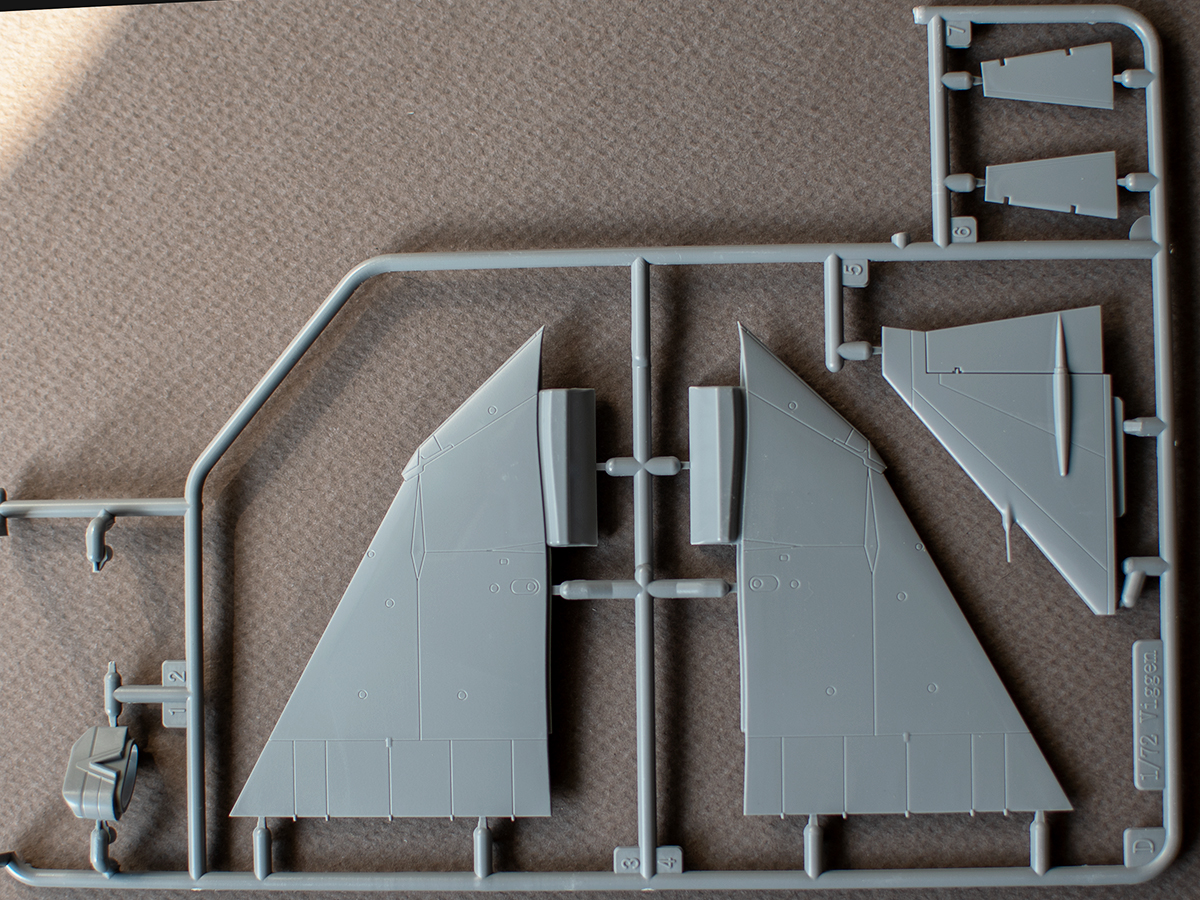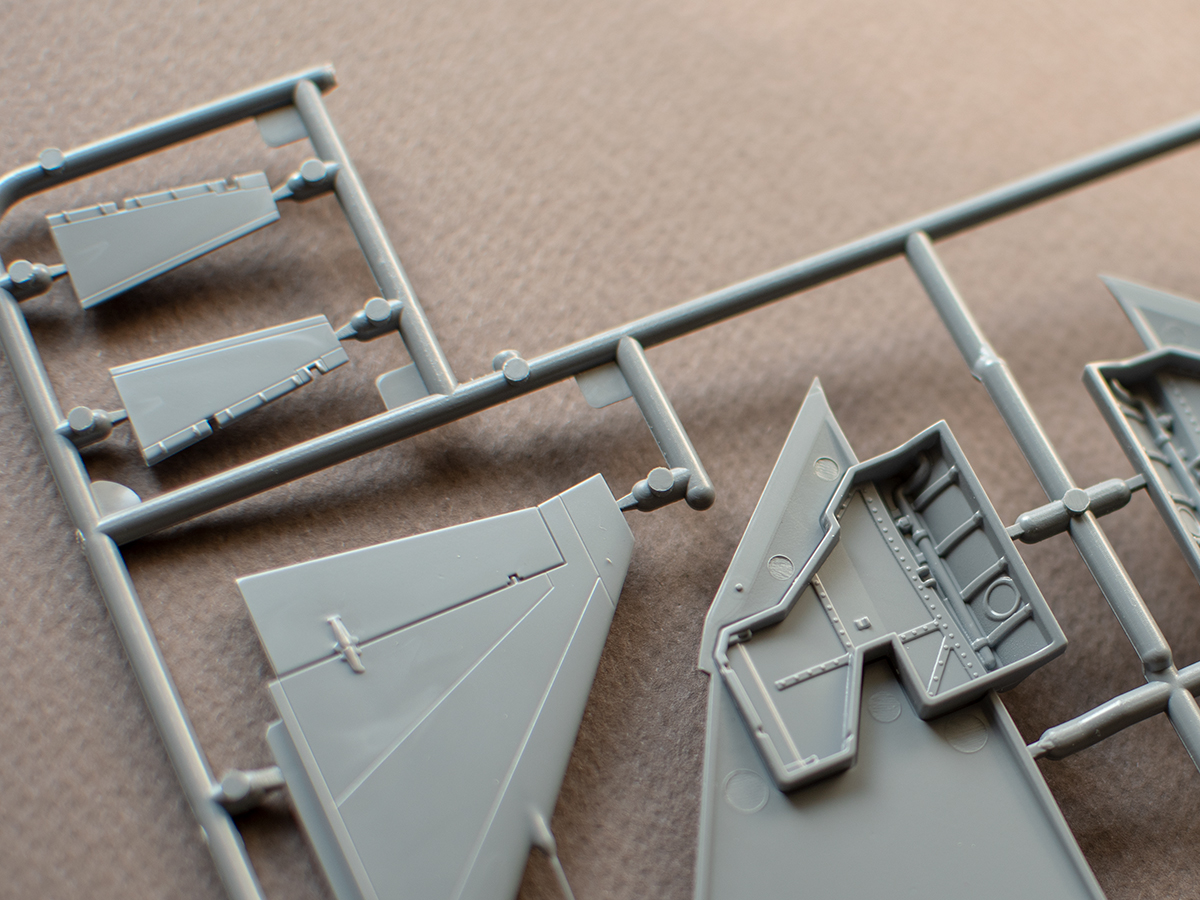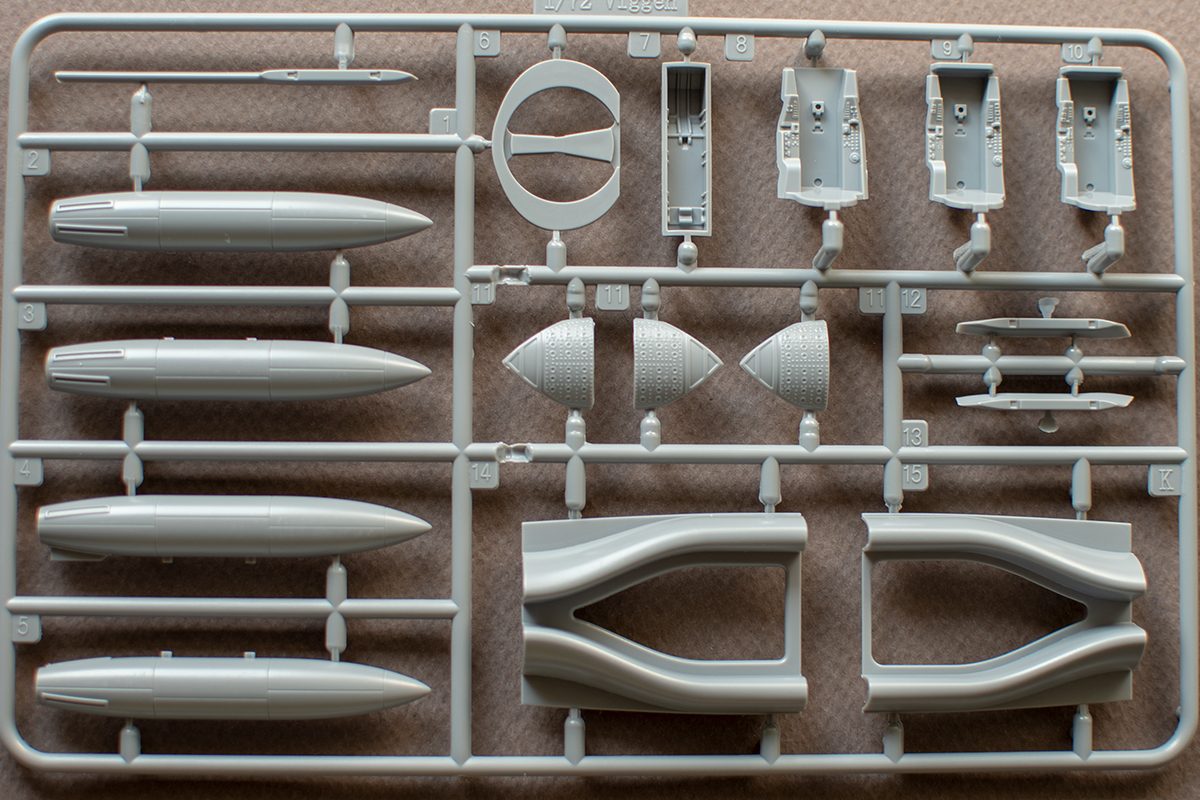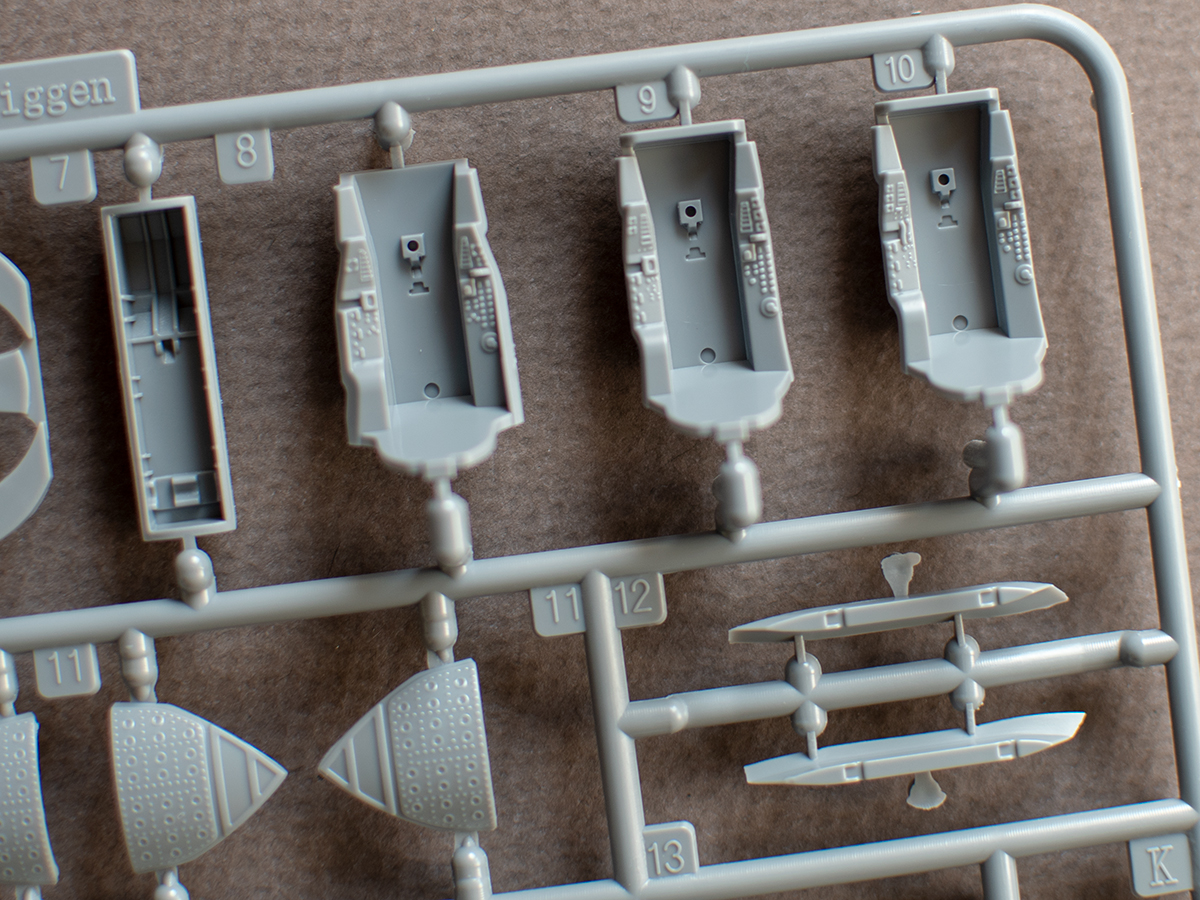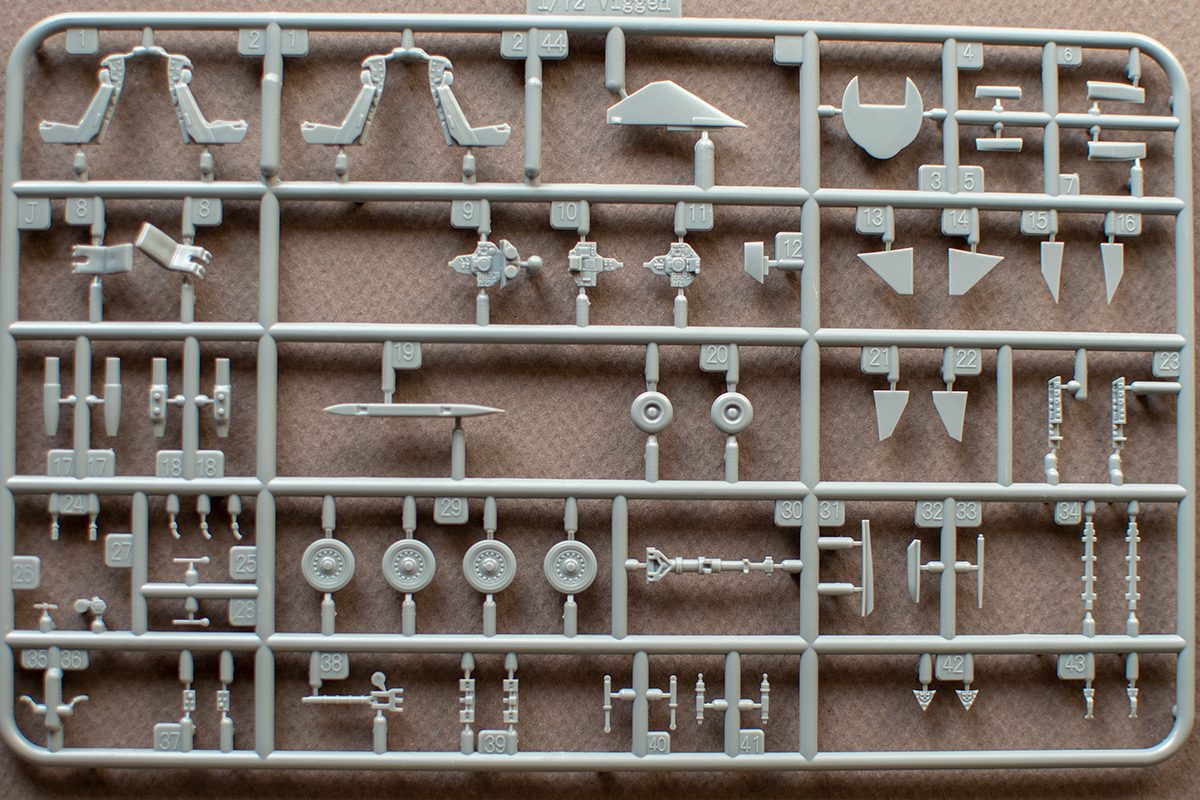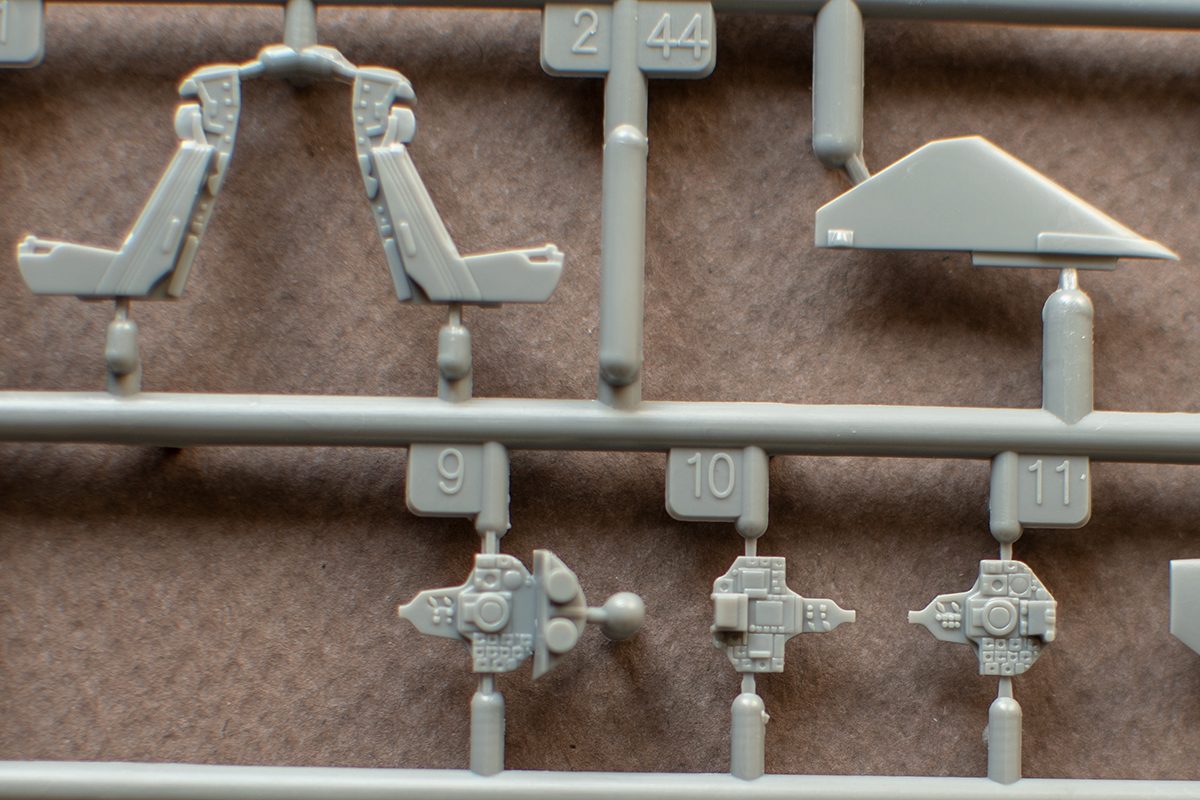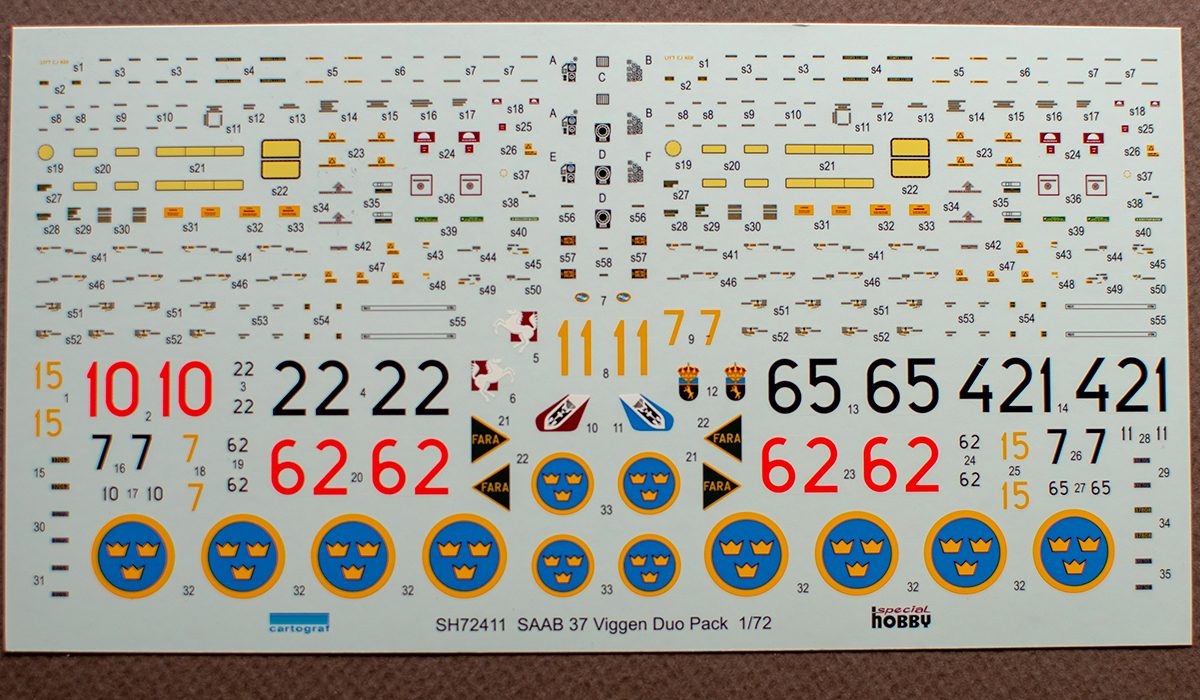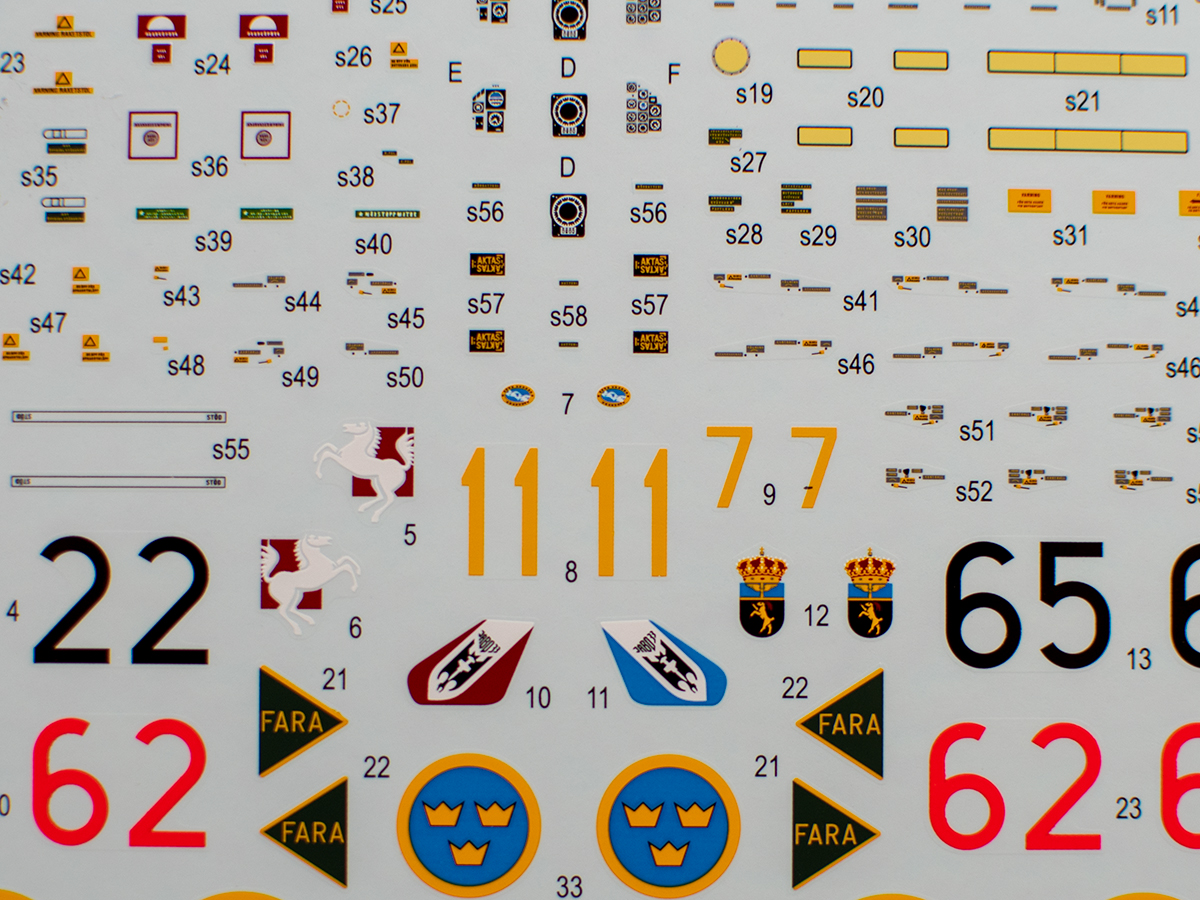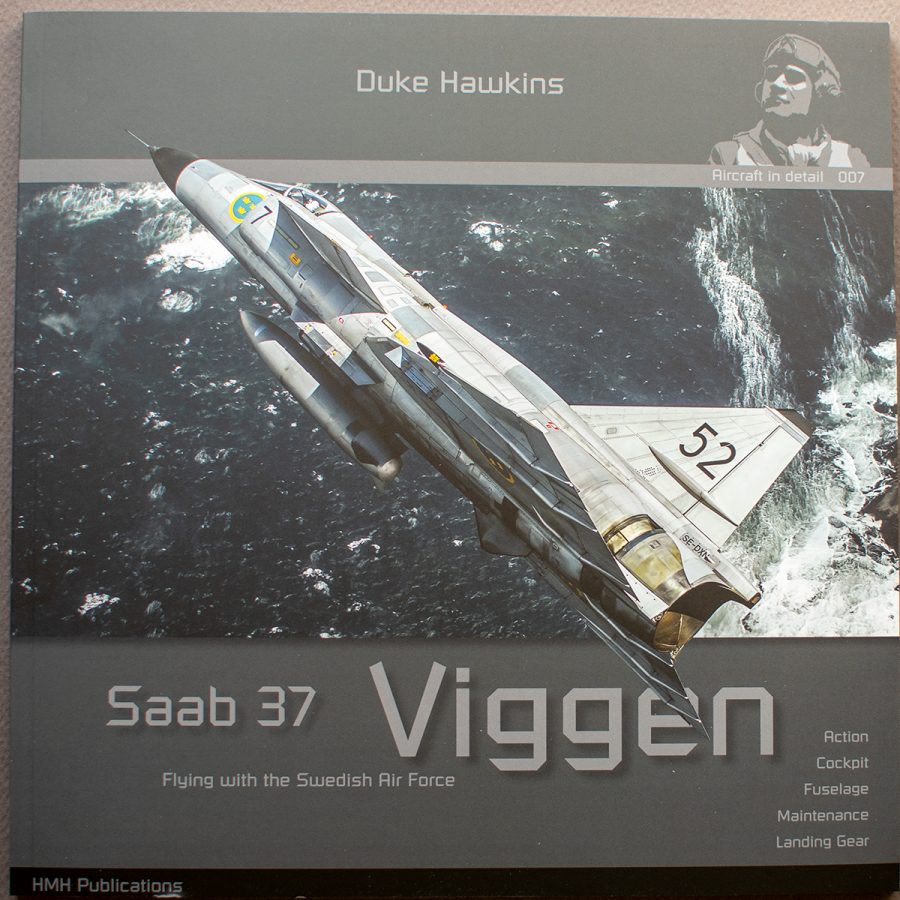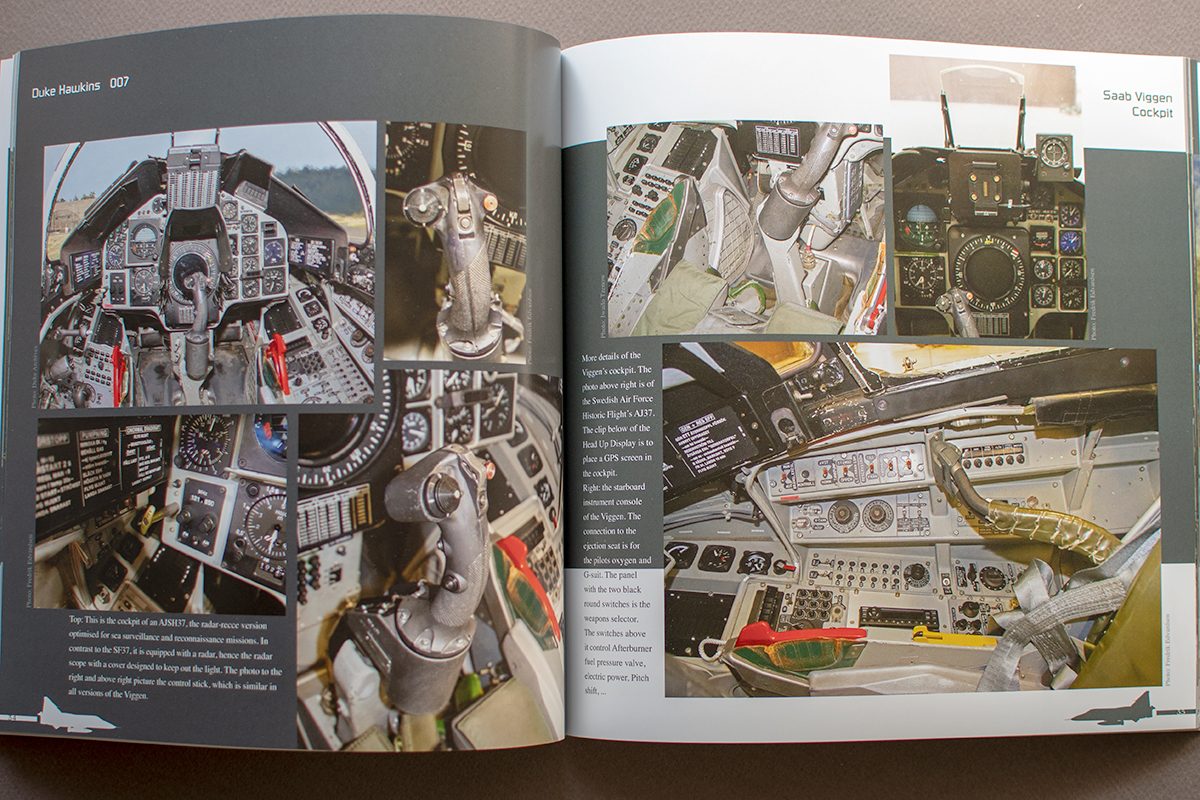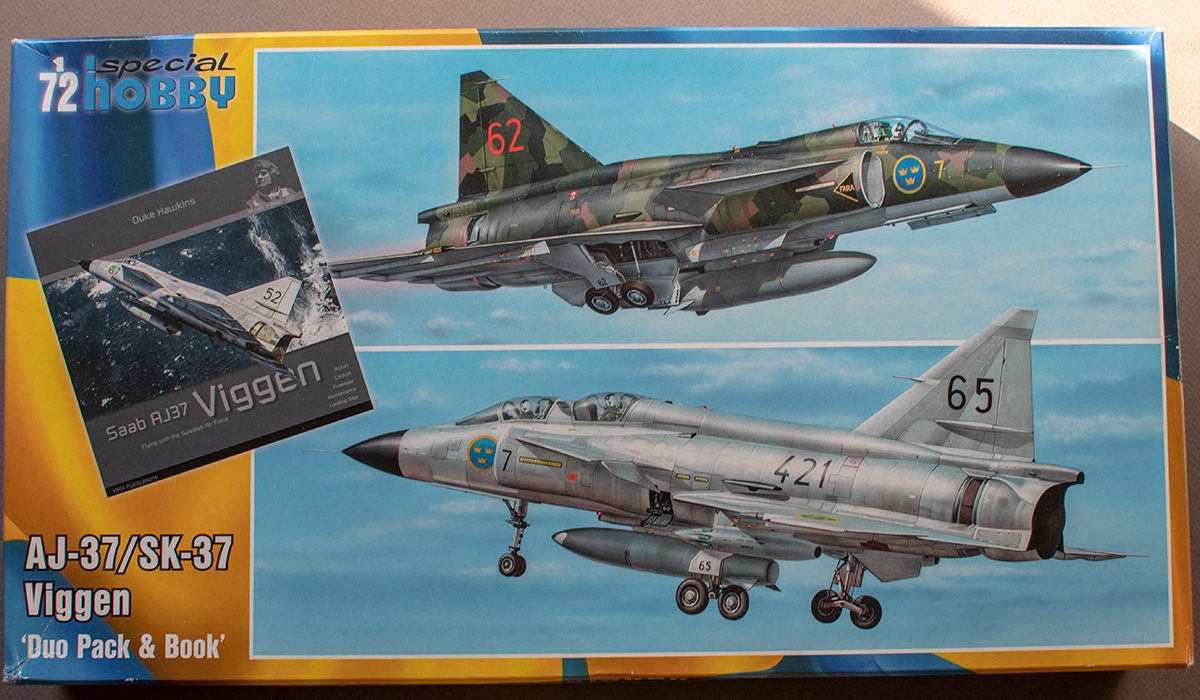
Sweden has always been a very special country in my book with its peculiar machines, and the Viggen is no exception. For the longest time the only kit in the scale has been the Heller one, so when Special Hobby announced their joint project with Tarangus I was excited. As I had seen a two-seater flying some time before that – and was suitable impressed by both appearance and performance – I opted to purchase the twin pack, attracted by the number of versions AND the photo book.
The box is BIG, in fact it is bigger than most 48th kits I have, as well as some 35th scale kit boxes in my collection. There are 2 transparent bags with parts, 2 instruction booklets (1 for each the single and double seater), a decal sheet, and the book. The last 2 items are fixed within the box with cardboard inserts, stapled to the box sides. Except for the instructions all items are packed in separate plastic bags.
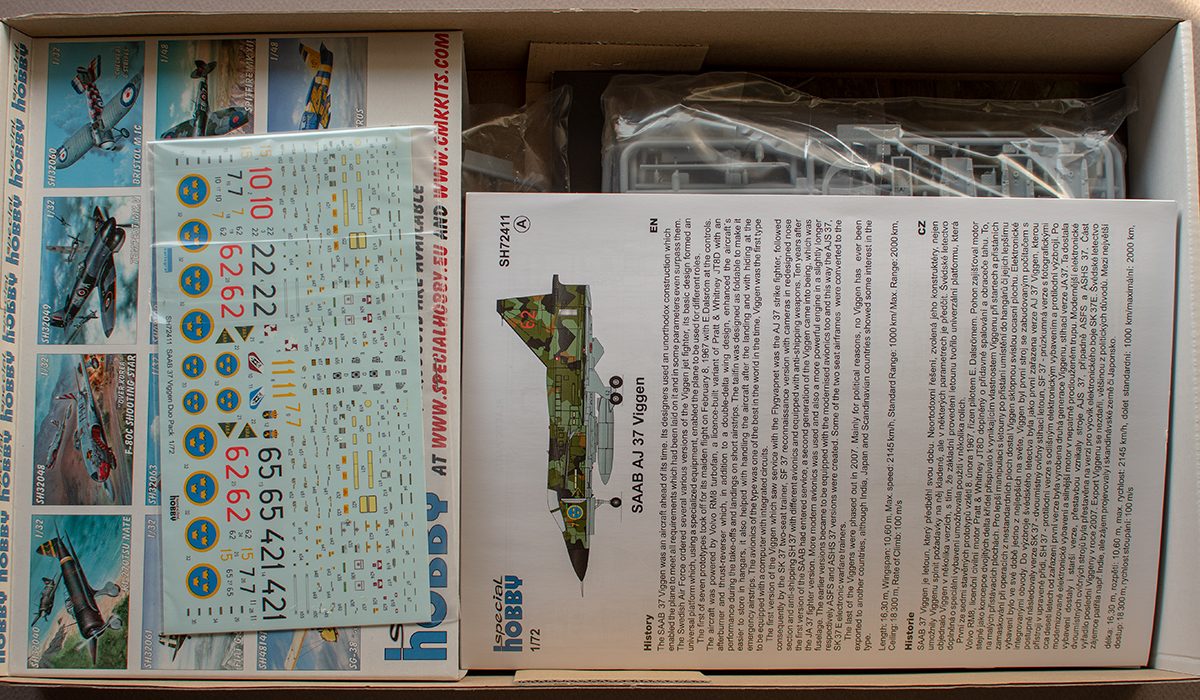
I’ll start with the instructions. The story is the same on top cover, but you can easily tell which one is which. Both booklets follow the same layout, same type of steps and drawings. The parts plan is nearly identical, naturally there are some different parts, and the part plan accordingly shows different “unused parts” as well as parts used in the construction sequence. There are also stencil schemes, decal/paint guides, Gunze paint references and the typical Special Hobby “other products” sections. For whatever reason I’ve taken photos pf the 2-seater booklet and parts, but there will be the respective shots of kit-specific items.

Special Hobby AJ-37 Viggen parts plan 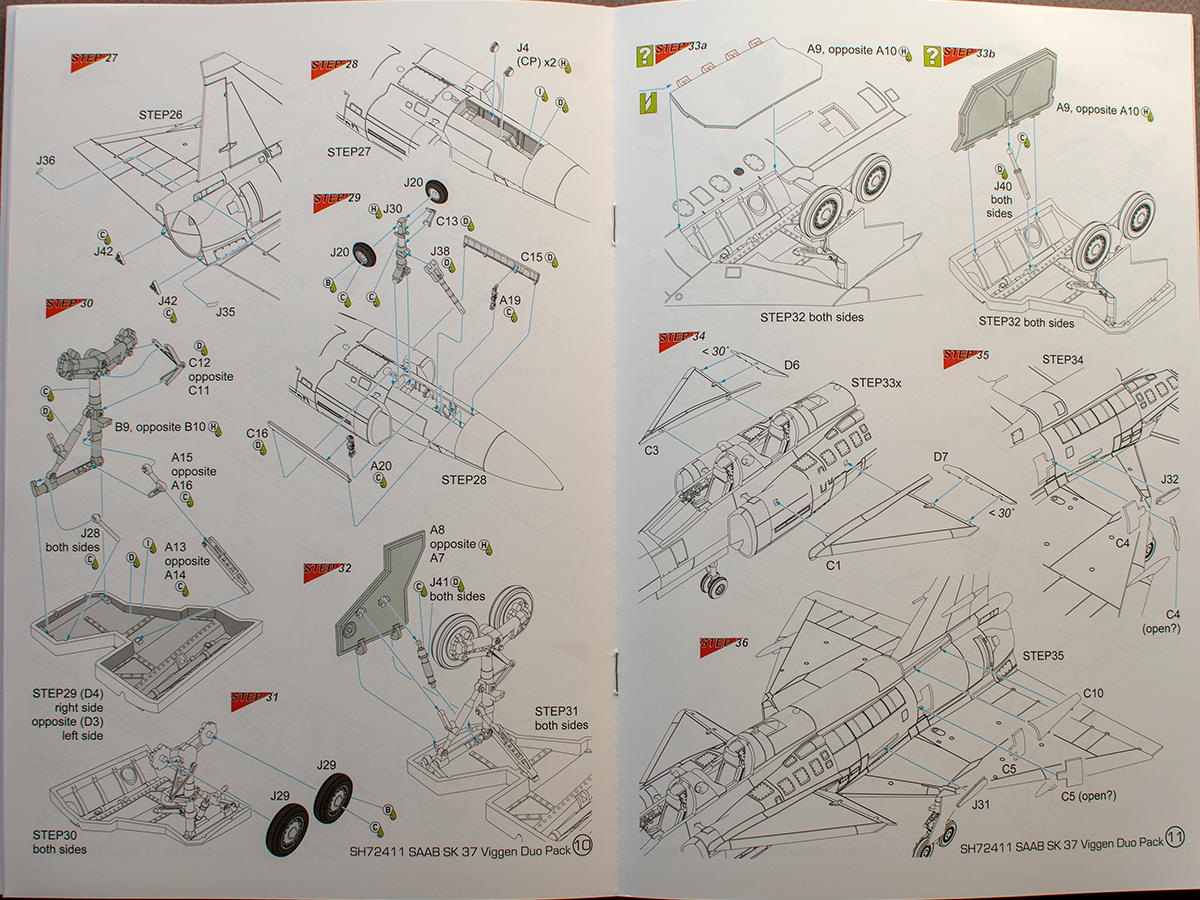
Special Hobby SK-37 Viggen construction steps 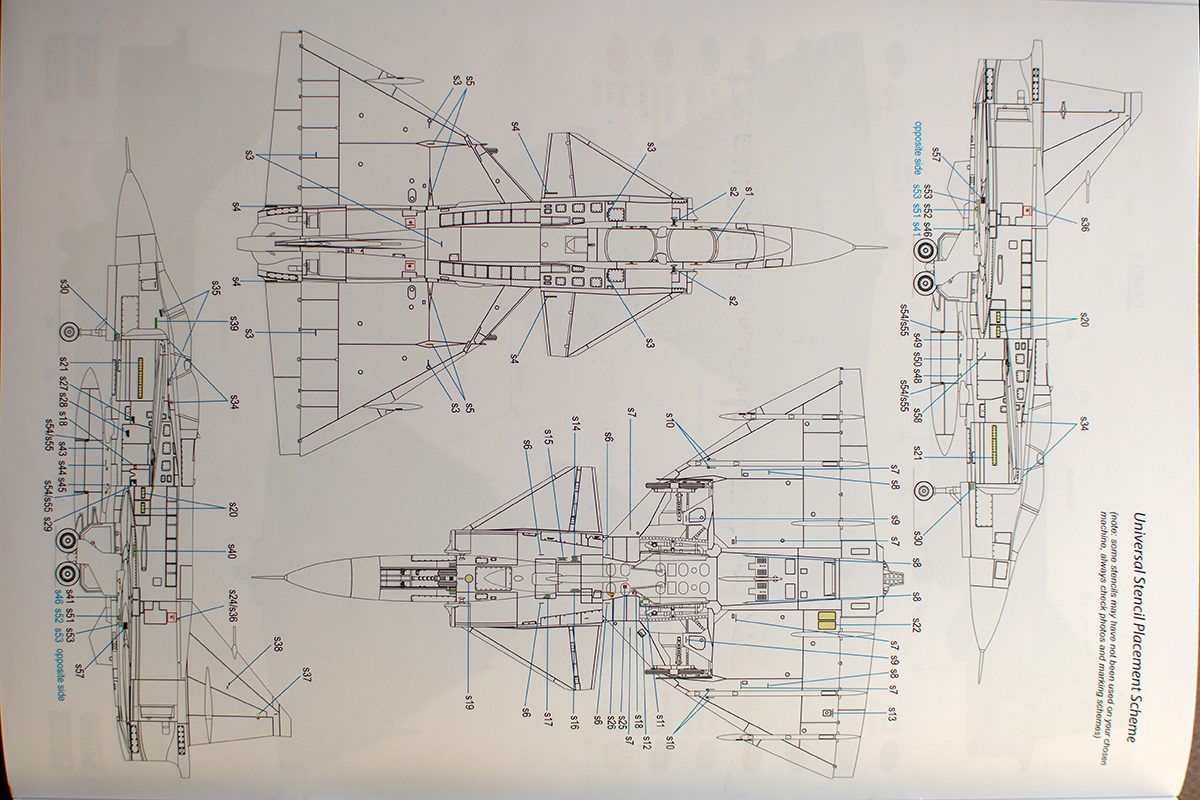
Special Hobby Viggen SK-37 stencilling diagram 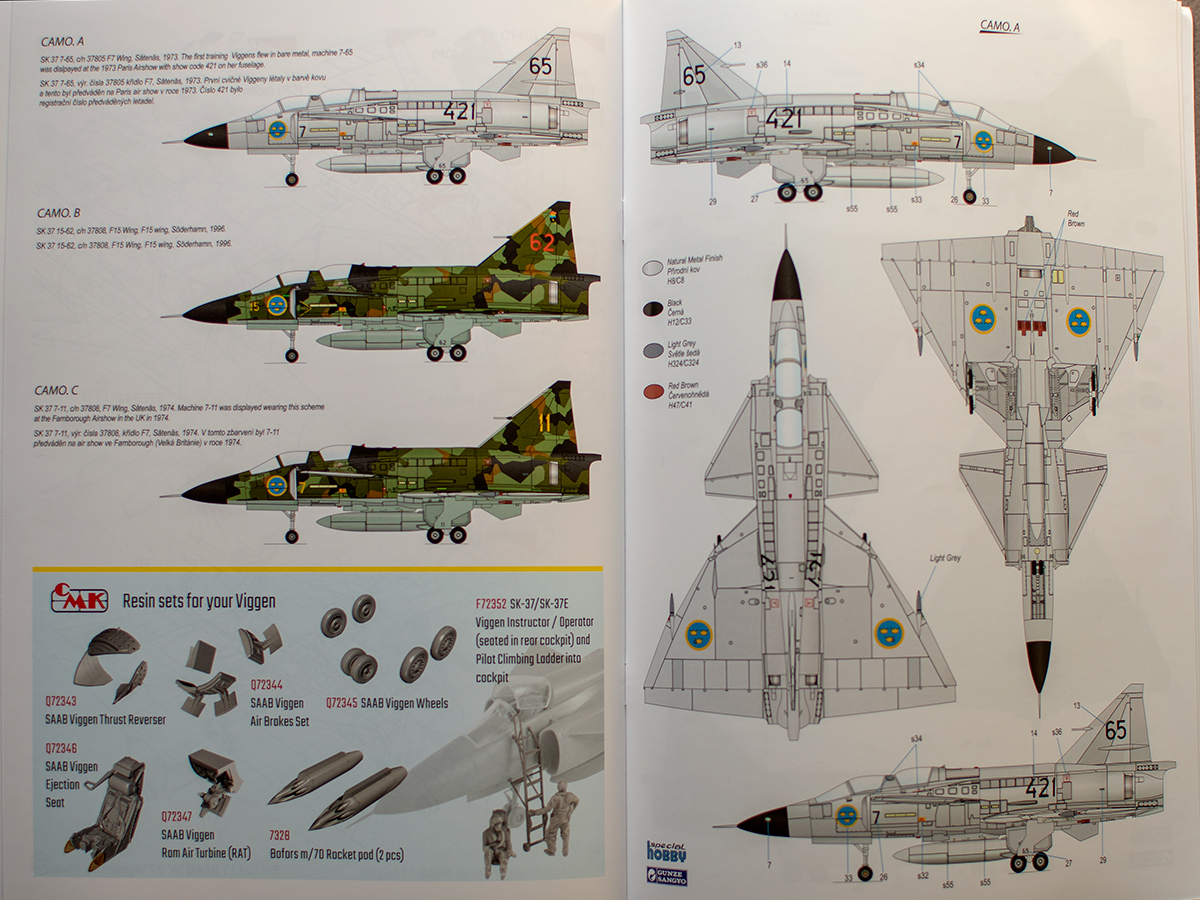
Special Hobby Viggen SK-37 markings and painting guide
In some regards SH is overtaking Eduard: there is no weaponry included in this set at all as you will undoubtedly notice, as we go thru the sprues. There are 7 of them, 6 in light grey plastic, and a transparent one. Any underwing stores (except the fuel tanks) will have to be from your spares box or a separate order from SH if you did not know better and order the weaponry with your Viggen kit(s).
There are 8 sprues for each kit – 7 of these are common (including 1 with transparencies). The 8th part tree has the specific parts:
- the AJ-specific sprue holds a different type of vertical stabilizer that is shorter than the 2-seater one included by default in the set,
- the SK-specifc parts include a separate fuselage top section to accommodate the 2 cockpits, a blade antenna and 2 additional parts.
The sprue gates are visibly thinner than releases before 2015, the details are well-defined, and there is no longer a feeling the kit had manually-shaped master. There are – notably – locating pins and corresponding openings, which provides a bit more confidence that the result will be a kit that actually fits.
You see sprue A with the fuselage top (with multiple spaces for various inserts, including canards), main landing gear fuselage doors, compressor face, engine exhaust assembly and tail pipe plus a few more. The fuselage top is created via slide molds (see runner frame forming a portal for the port side tool and the empty space in the middle), the panel lines and rivet lines are consistent and (to me) reasonable in size for the scale. Details are well-defined, edges are clean and straight, you can even see some intakes molded open, and lightening holes over the exhaust opening in the tail cone.
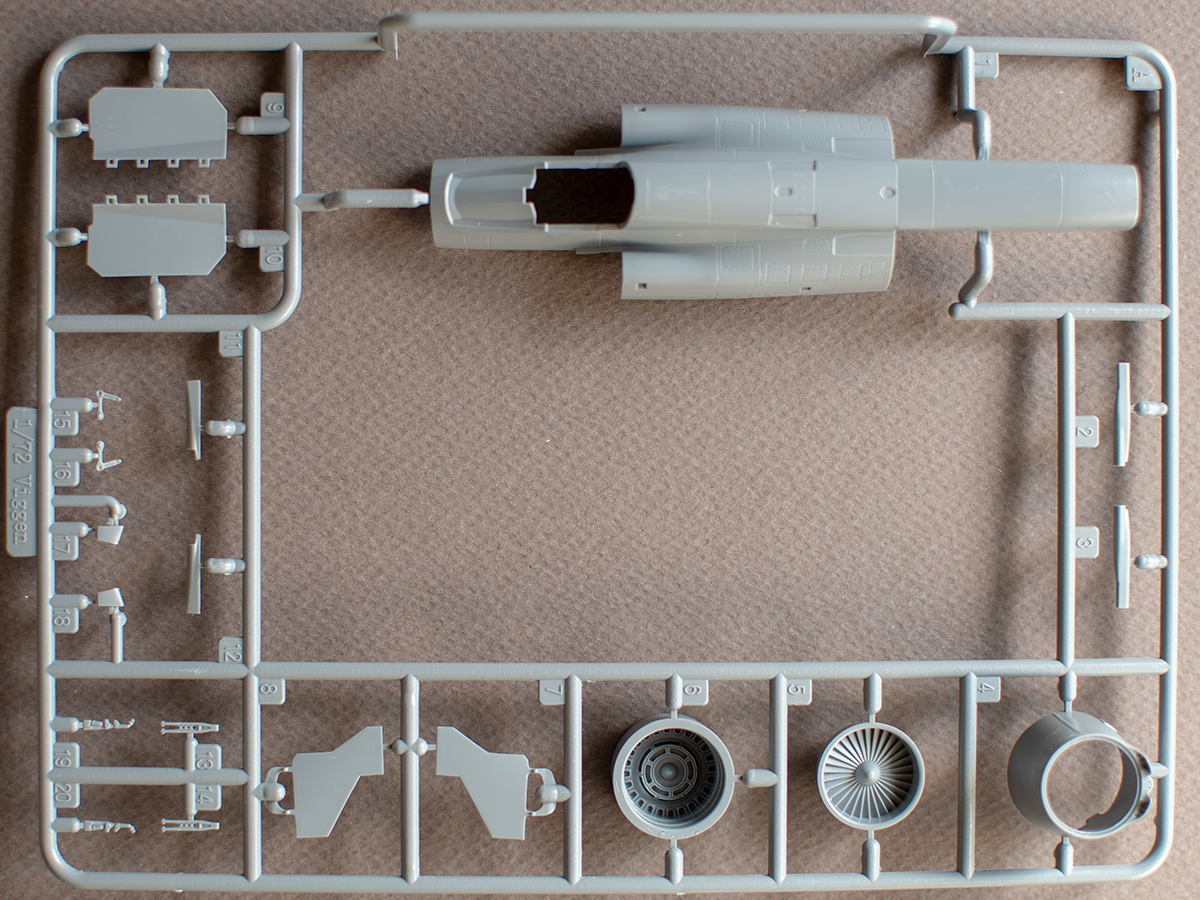
Special Hobby AJ-37 Viggen sprue A 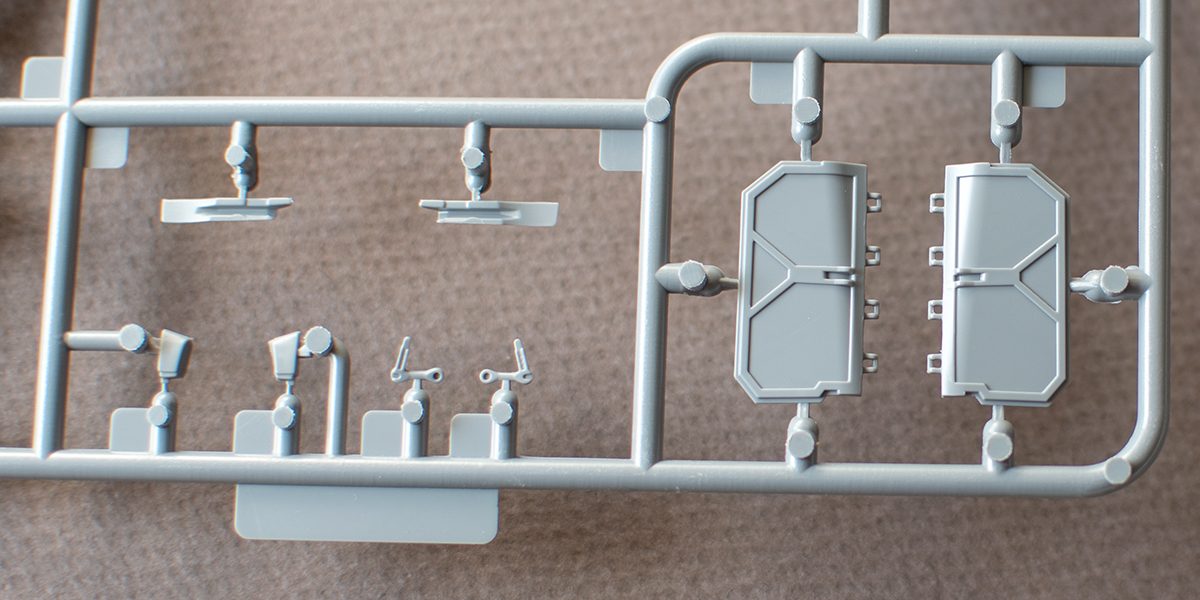
Special Hobby Viggen main gear bay covers 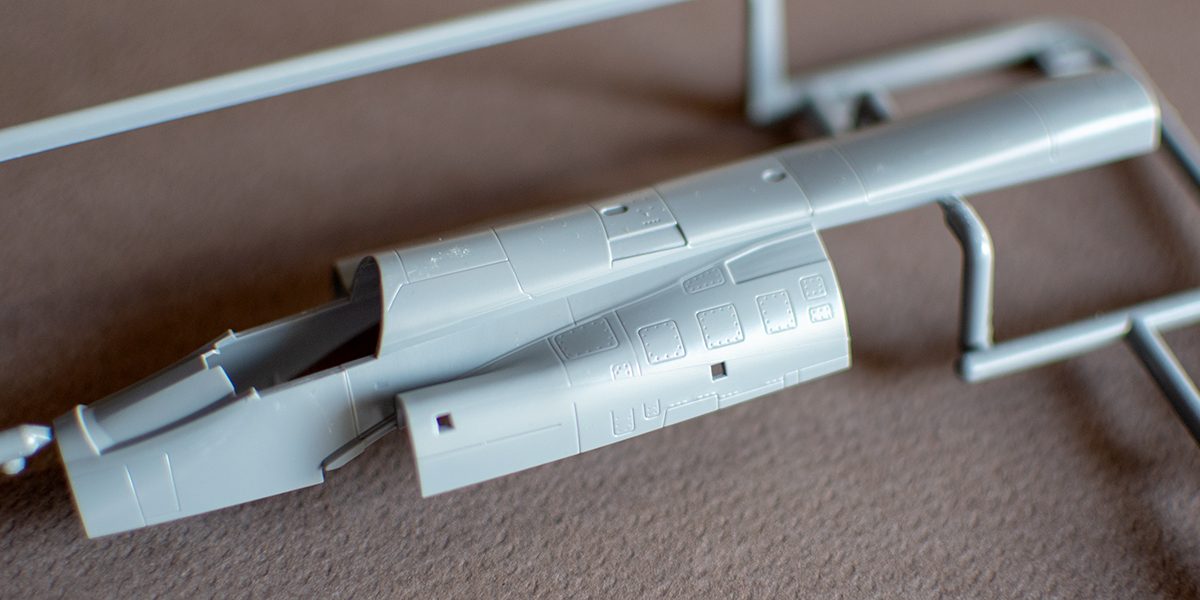
Special Hobby AJ-37 Viggen fuselage top 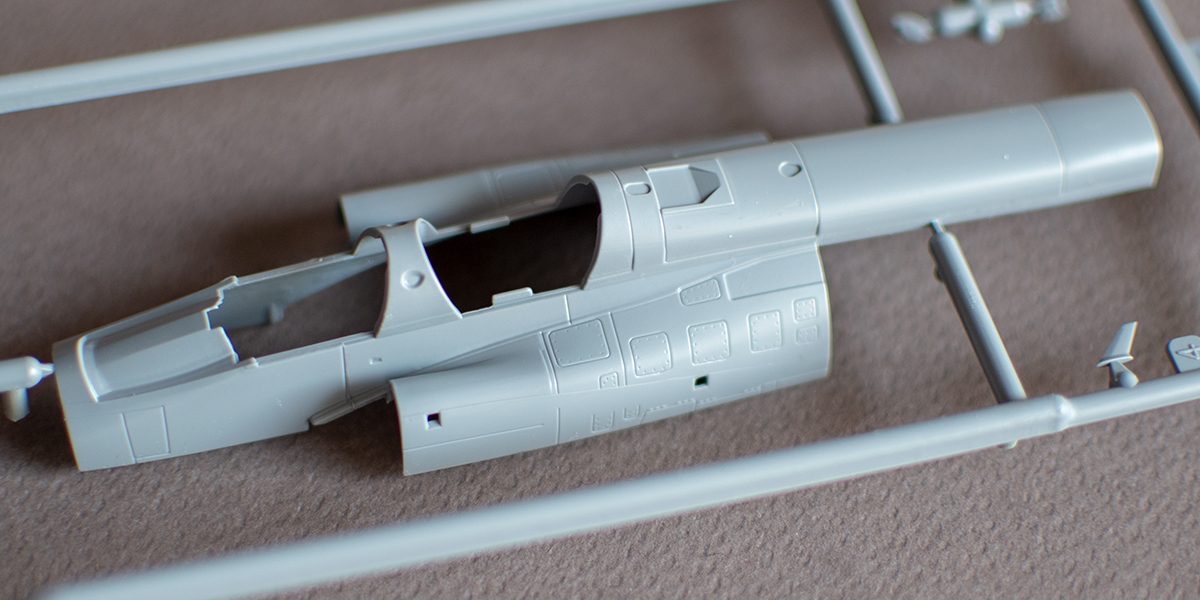
Special Hobby SK-37 Viggen fuselage top 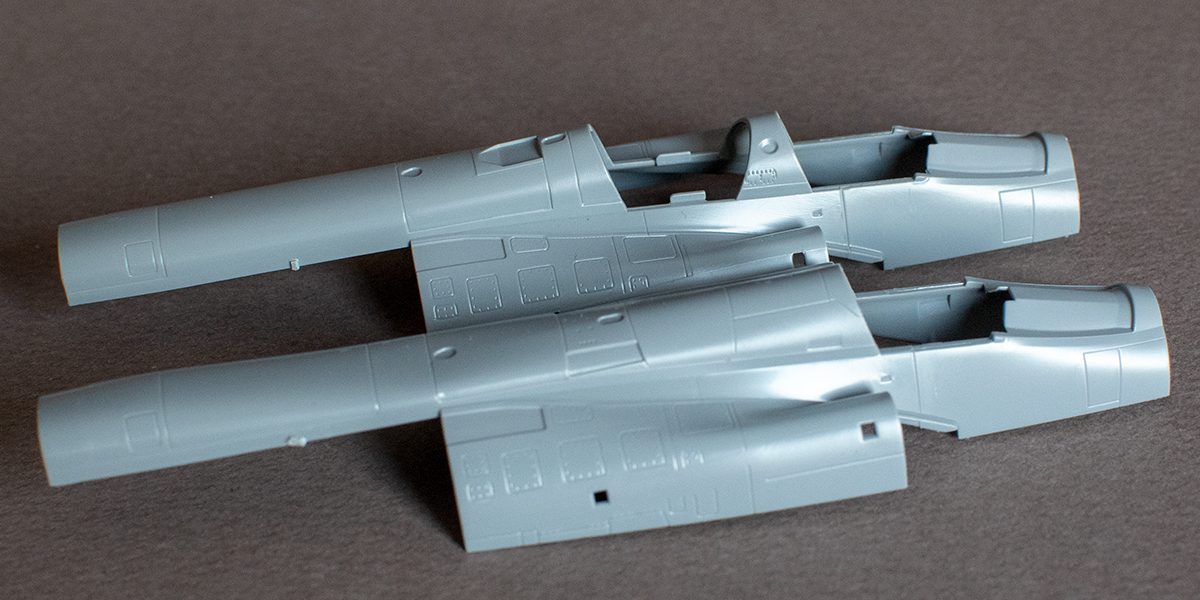
AJ-37 (near) and SK-37 Viggen fuselage top comparison
I am also including a comparison of the AJ vs SK fuselage tops to see how they will be drop fit in whichever configuration you will choose. You can see the twin-seater’s back detail is a straight line after the cockpit opening, while the part for the AJ fighter is concave. The SK-associated part is on a separate parts tree marked I.
Next is sprue B, which has the lower half of the front fuselage, 2 of the pieces forming the rear fuselage, the main gear legs and a few more parts. Again – consistent panel lines that don’t go soft on the sides of the part thanks to the slide mold, symmetric lines, good looking details and section, including on the main gear. Considering the quantity of plastic and the need for nose weight – I hope the gear will support the airframe properly, as the wheels are on one side of them only.
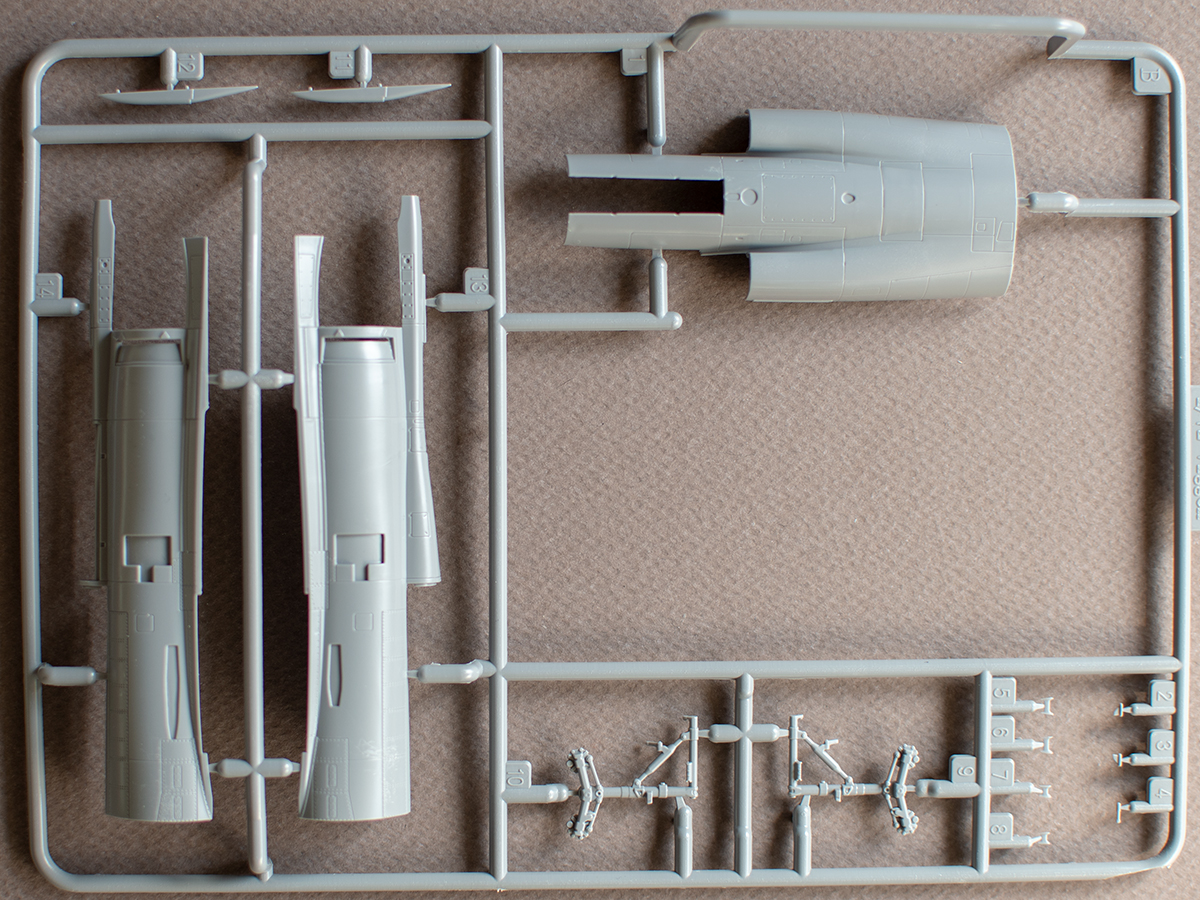
Special Hobby Viggen sprue B 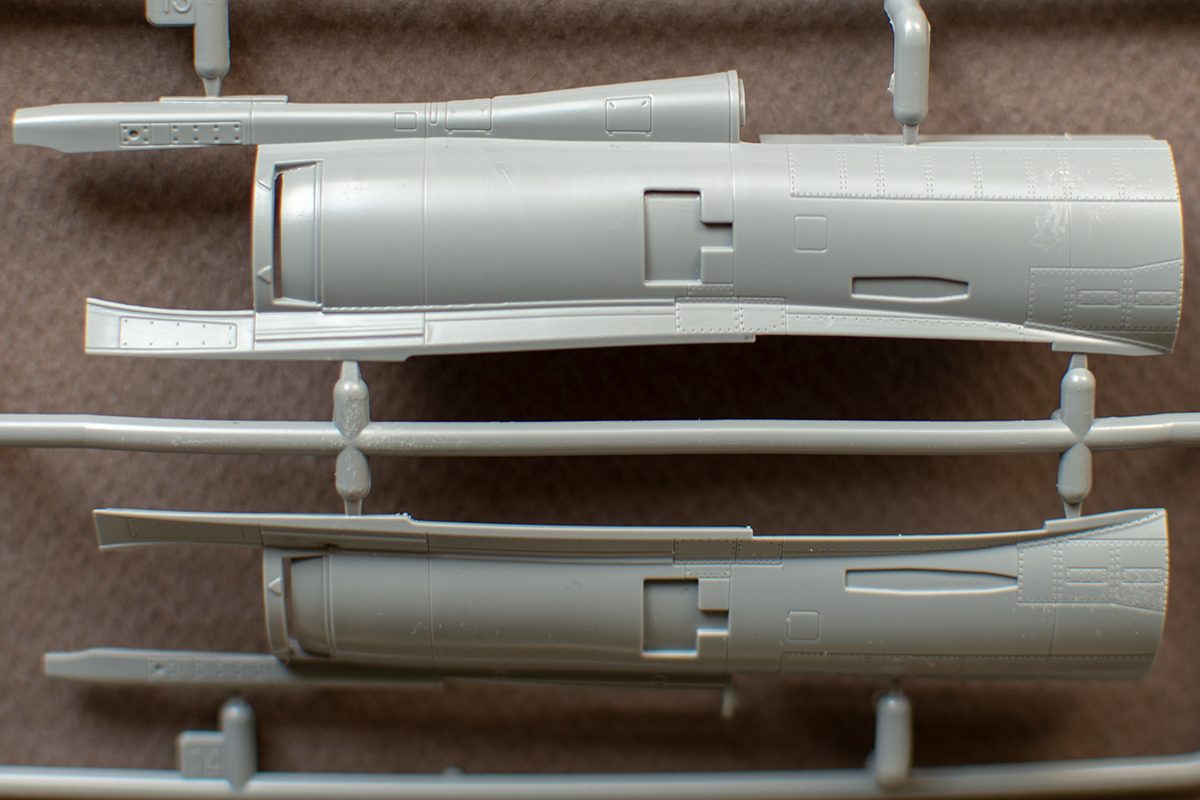
Special Hobby 1/72 Viggen rear fuselage halves 
Special Hobby 1/72 Viggen main gear legs
Sprue C – lower wing, canards, etc. Again – well defined detail, locating openings for parts and underwing pylons, and the leading edge of the canards feature the characteristic aerodynamic twist. The movable surfaces of the canards are on a separate part tree. The trailing edge of the wing appears thin as the control surfaces are molded integrally with the lower wing.
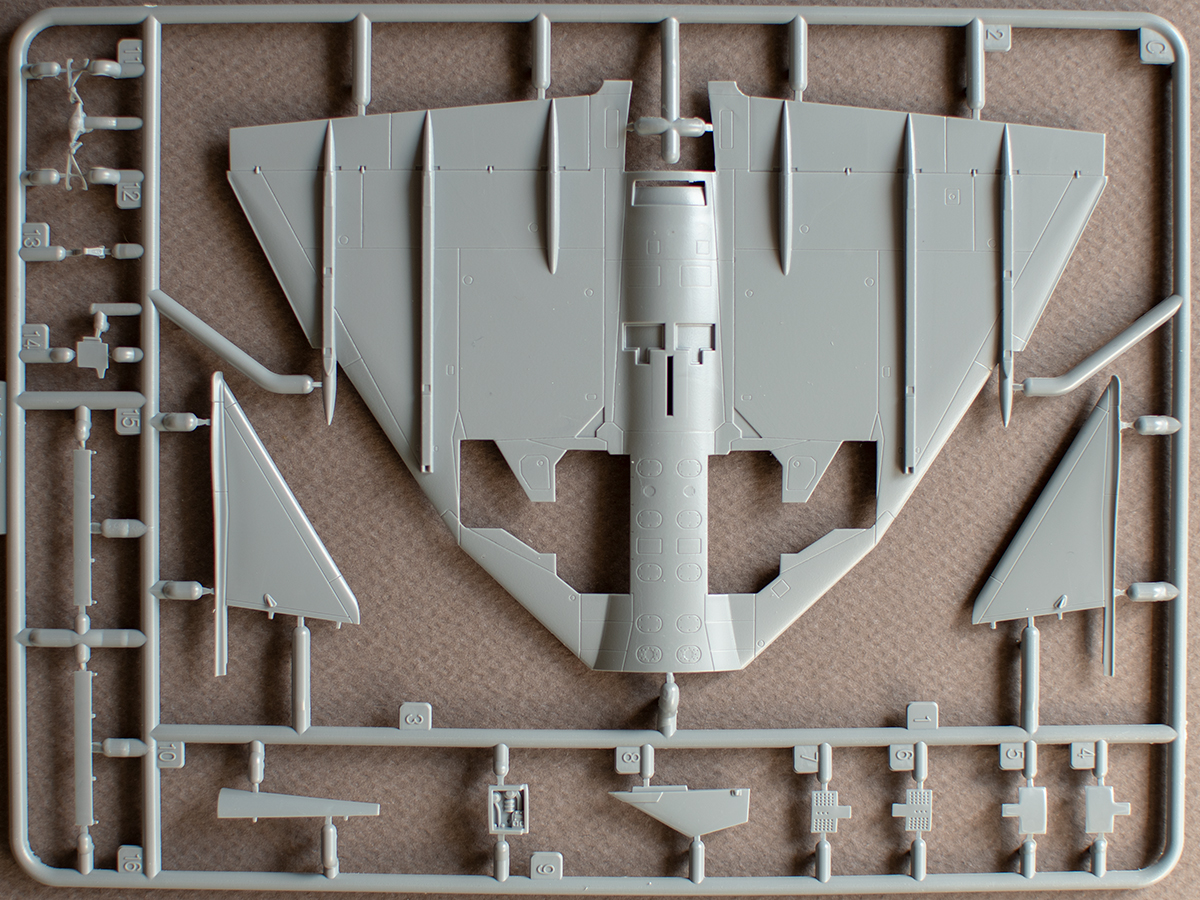
Special Hobby’s 1/72 Viggen – sprue D 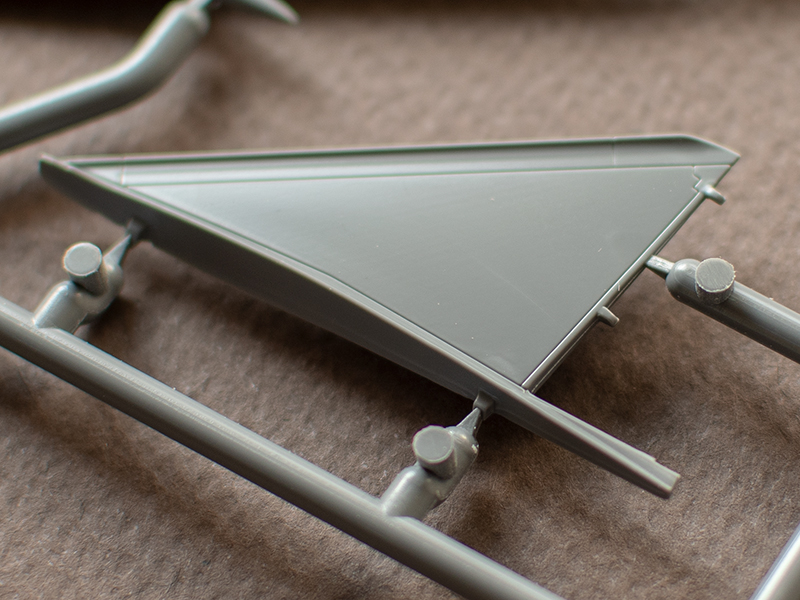
Special Hobby’s 1/72 Viggen – canards 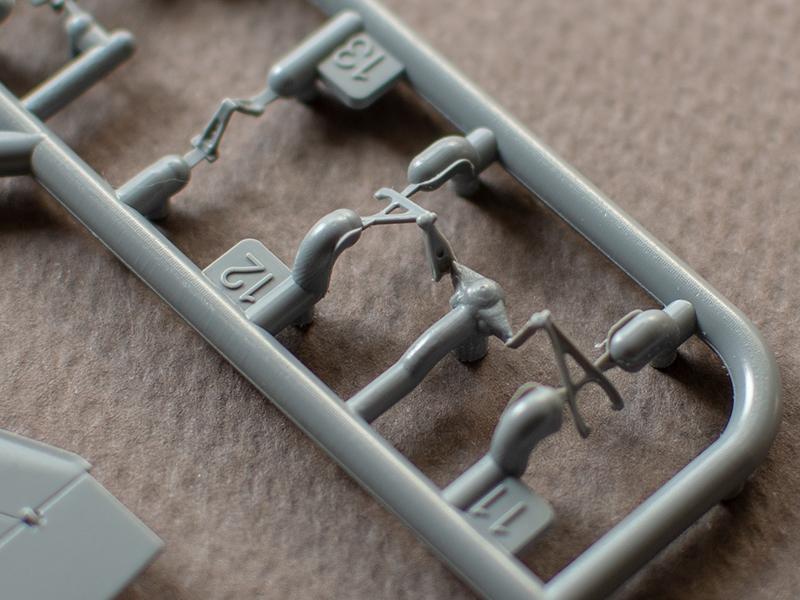
Finely molded drag links in Special Hobby’s 1/72 Viggen kit
Sprue D has the wing upper panels, intake inlets, and extended vertical tail. The part plan also shows the smaller tail for the fighter and the nose cone to both be located on this part tree, but they were separate frames in my example.
You can see the main landing gear bays molded integrally into the wing upper halves (much better than separate pieces), including some structural detail. They appear believably deep, which I can certainly appreciate.
The 2 types of vertical tail included in the AJ-37 kit for comparison – the lower one is for the fighter, with the taller fin with swept-back destined for the trainer. Note different pitot tube positions, as well as the mold shift making the short one look thicker. The panel lines and hinge detail is identical.
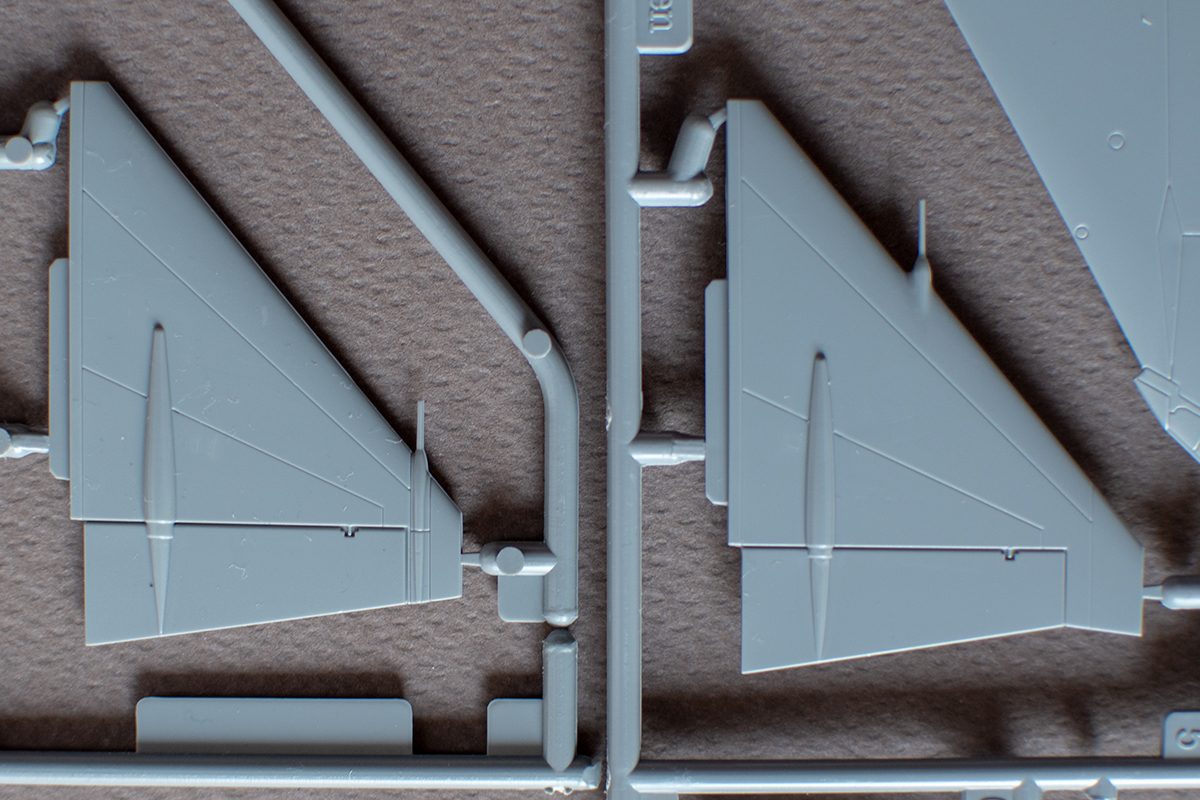
1/72 Viggen vertical fins – fighter (left) and trainer (right) 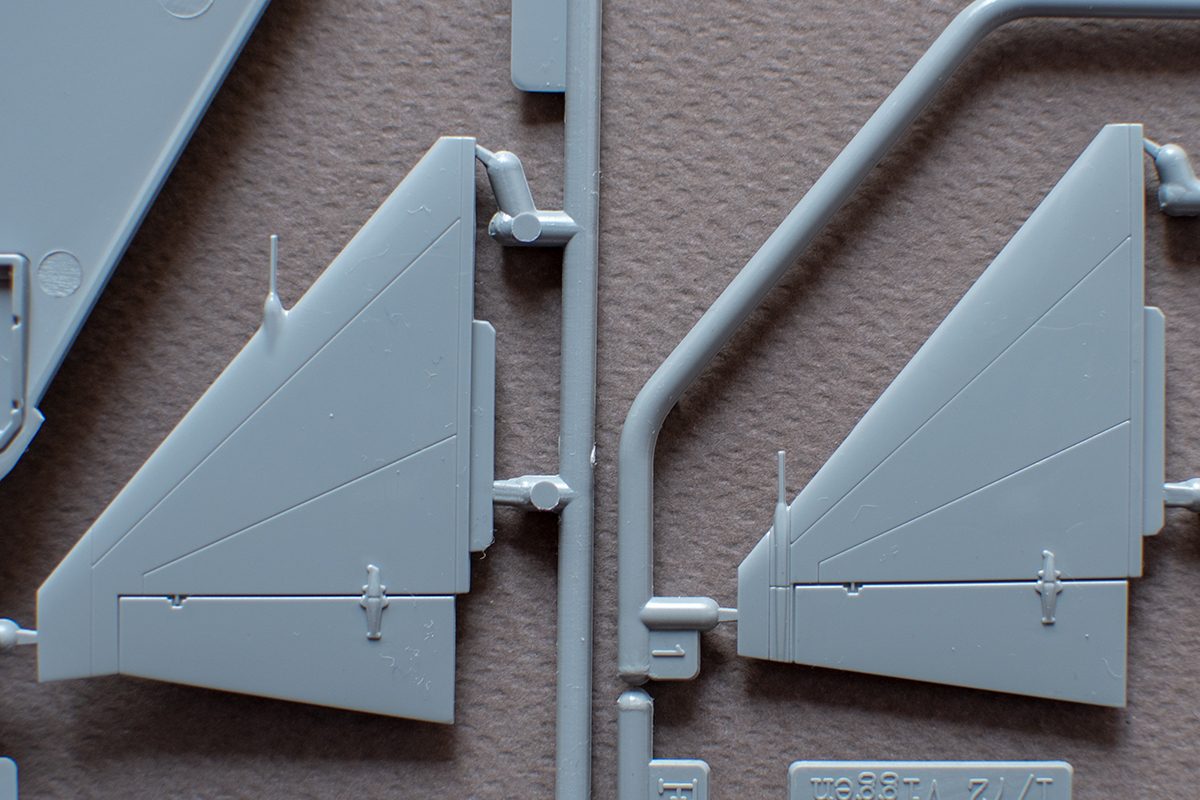
1/72 Viggen vertical fins – fighter (right) and trainer (left)
Part tree K has 3 types of cockpit tubs (2 different layout for the front one, 1 for the rear), intake ducting, external fuel tanks, the 3 petals for the thrust reverse. Note the latter are only detailed on the inside – at least the detail is consistent and symmetric on the other 🙂
The intake ducting appear rather narrow and will hopefully fit well enough to not require filling.
Sprue J has the ejection seats, instrument panels, wheels and a host of additional details. No mold shift or flash noted.
Honestly, considering how deep the cockpits are in aircraft before the 1980s – I’d say in 1/72 the detail is satisfactory despite the half-hearted attempt at both the instrument panels and bang seats. Wheels are symmetric rather then flattened and bulged, detail on hub is only present on one side, as the other will be covered by the simulated braking apparatuses molded to the main gear legs.
Transparencies are also marked as J and are – again – identical for both airframe types. Parts are clear and of medium thickness. Aside from the canopies there are various lights and what could be camera window(s) for the future recce variants.
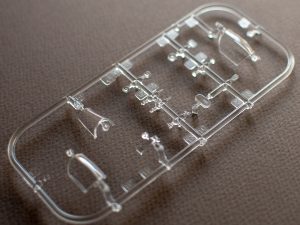
Decals – 3 options per type, all on a single sheet for this boxing, crafted by Cartograph. With their saturated colors, in register print, and beautiful detail, these should bring color to even the greyest of schemes (though only splinter-camoflaged and bare metal airframes are included).
Note the JaBo 33 fin badges from an airshow in Germany, incorporating the silhouette of the then-current F-104 on strength of the Luftwaffe unit. Also visible is the crest of F15, the Hälsinge Air Force Wing, for one of the SKs.
Another extra in this box is the beautifully printed photo book by Duke Hawkins, titled simply “Saab 37 Viggen”, that will be useful reference as you build your kit.
It spans 82 pages on high quality paper, and includes hundreds of photos from various spots all across the airframe (as well a number of outside shots from various angles), making the purchase of this kit worth every penny. The price of the book alone is 20 Euro from retailers around the world so this set is a bargain despite the missing later JA-37 version.
